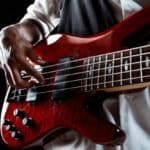Playing in a band is playing a role.
Each musician has their instrument, and with such, a task.
For some members, it will be keeping the rhythmic beat. For others, to be in front of the audience and stand out.
What’s interesting about these last two is that guitars can do both.
Sometimes, this means having more than just one guitar.
Bands have two guitars for different reasons: getting thicker sounds and varied tones, and for an overall versatility as a band. In most cases, one is a lead guitar while the other a rhythmic, although they can switch their roles as well.
This has been just a quick summary of the main characteristics.
There’s a lot more, and you’ll learn everything if you stick here till the end.
Do all guitar players in a band play the same?
This is a tricky question.
In part, they do. In part, they don’t.
See, two guitars can play the same.
It’s a way of emphasizing the notes and making an overall fuller sound.
The guitarist too can play the same chords but in a different frequency range.
Doing so avoids colliding with each other, which could result in an unpleasant melody.
On the most part, though, one guitar takes the lead role, and the other the rhythmic one.
Some bands even alternate between one or the other, playing a different role each.
This means that both guitars don’t always play the same.
It depends on the band, the genre, and the agreement both guitarists have.
5 reasons why bands have 2 guitars
Below you’ll find a list of the reasons why a band has two six-strings instead of one.
1. Wider sound
It is not merely what the band plays, it is also how they sound.
Having two guitars playing the same creates a chorus-like experience.
It is known as double-tracking, as is used in studio recordings a lot.
In short, it is to apply extra layers of guitar for getting a thicker sound.
2. Tone differences
One guitar could get a brittler tone to highlight melodies, while the other a more distorted one for covering “empty” spaces.
One uses a pedal effect, the other toys with a completely different one.
And so on…
3. Versatility
Performing the same notes is not mandatory.
Having two guitars is a possibility for contrast.
While the main guitar has a specific style, the second one has another.
This is great because both can fusion their ideas and bring outstanding results.
4. Complement weaknesses
They can complement one another by playing what the other cannot.
In other words, if a guitar is not the best at soloing, then it might be good for harmonies.
Plus, one might know certain techniques that the other doesn’t.
That way, both focus on their abilities, knowing that the rest is being attained by their partner.
5. Chord variation
One plays open chords, the other sticks with power chords.
The same goes for triads vs extended chords, or root vs inverted chords.
Harmonies can get as complex as you want the more members you have in your band.
It’s all just about stacking notes with good taste.
Drawbacks of having 2 guitars or more
Having two guitars is rather useful.
However, there are a lot of reasons why it could be a bad decision too.
To begin with, the fact that working with more people is like a coin: it has two opposite sides.
Two guitarists can come out with lots of ideas and riffs and solos and have extra material for an entire double album.
But those two guitarists have two egos as well.
Their ideas could collide because using one of theirs means to give in the other one.
After all, one cannot please everyone.
Also, a fight for who plays what and when is a real possibility.
It could be rather problematic unless, of course, both learn to cooperate and share the spotlight.
It can occur too that there’s an unbalance in professionalism.
There are different levels of proficiency in every aspect of life.
It is a fact that not every guitarist plays alike.
If one of them is a professional and the other a beginner, then they’ll find it hard to bring ideas into reality.
Now, this shouldn’t discourage anyone who’s trying to start a band.
Truth is, this weakness has a strength.
Playing with experienced musicians pushes inexperienced ones to drastically improve their abilities.
Generally, in less time than it would take if they practiced on their own.
If this disadvantage is seen as an opportunity rather than a disappointment, then the results will be fruitful.
Bass can sometimes do the job of a second guitar
Depending on the band, the bass guitar will have more or less prominence.
There are certain groups in which the bass is as powerful as a guitar both in sound and performance.
This tends to be the case of power trios, such as Rush, The Police, Motörhead, and The Winery Dogs.
However, we find the same role in other bands as well.
It’s the case of Black Sabbath, Kyuss, and Red Hot Chili Peppers, to name a few.
Bass there fulfills a wide number of techniques that a second guitar could do: filling in the empty spaces the guitar leaves, playing chords, or even soloing every once in a while.
In addition, a bass can even sound like a second guitar.
It all depends on the proper settings and effects.
Want the bass to resemble a guitar? Then go to your amp and add lots of gain, turn up your treble and mids, and reduce bass.
Work with some pedals too. You can get an octave pedal or a distortion. A fuzz could work too, especially if you gain stack everything.
Bear in mind that a bass guitar cannot sound 100% like an actual electric guitar.
If anything, you may find interesting tones that make for a more original experience.
Give it a try, and maybe you don’t need a second guitarist.
How do 2 guitars complement each other in a band?
The best way in which two guitar players complement each other is by assuming roles.
In other words, one musician becomes the leader, and the other one, the rhythmic guitarist.
The rhythmic guitar focuses on the main riffs, harmonies, and overall structure. This paves the way for the lead guitar, who is free for shredding, playing solos, and adding details that make the song more attractive.
Also, there are bands in which the role can be switched depending on the song. Vivid examples of such are Iron Maiden, Judas Priest, and Thin Lizzy.
There’s no need for just one lead guitarist. The two of them can be leaders and even play a solo each on the same song.

Hello there, my name is Ramiro and I’ve been playing guitar for almost 20 years. I’m obsessed with everything gear-related and I thought it might be worth sharing it. From guitars, pedals, amps, and synths to studio gear and production tips, I hope you find what I post here useful, and I’ll try my best to keep it entertaining also.





